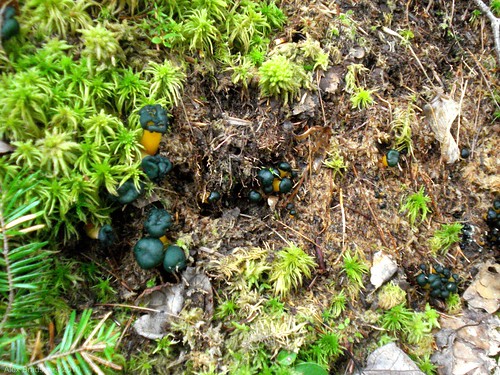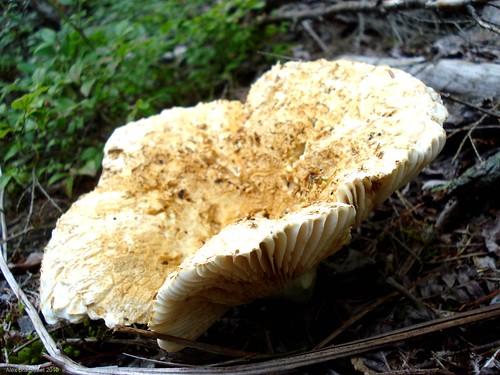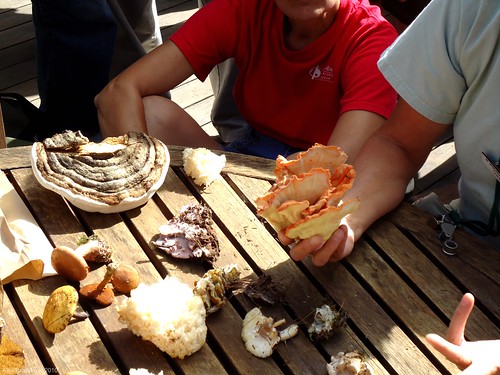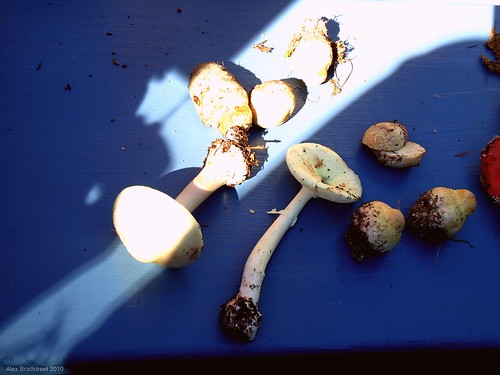Adam with calvatia cyanthiformis, purple spored puffball - not edible at this point, but good when younger.

Lobster Mushroom - this is actually a mold which makes a russula or other mushroom non-toxic - although this looks amazingly like a chantarelle, not growing on wood, not real gills, etc. We'll have to check back a bit earlier in the season next time, not just for the puffball above but also for this little guy.

Green Jelly Club - leotia viscosa - any of the slime molds are gross IMHO.

Large, Brown, Mystery Mushroom - no idea if the gills are attached or detached, veil or no veil, shape of the base, etc. It was about the size of a small dinner plate.

Based on what we learned at the Maine Mycological Foray on September 18, I've taken a stab at identifying them. The Foray was fun, although the blazing hot afternoon sun made it hard to concentrate on the identification speakers. At the start of the day, we looked at examples of some things we may want to find.

- hiricium americanum, which I know I've seen in my parent's woods before. Here is an excerpt from the University of Wisconsin - Fungus of the Month website: "It's quite delicious, with a taste reminiscent of lobster if it's properly prepared. We like it lightly sautéed in a mixture of olive oil and butter, with just enough heat to turn the teeth a golden brown. It also makes a fine TM. You might also try it in soup, as a substitute for rice, noodles or ancini de pepe (or other little Italian pastas). It's great in stir fry. "Lobster Helper
- calvatia gigantea, someone brought a beautiful specimen that they sliced into sections and handed out to certain people - I guess its who you know.
- laetiporus cincinnatus, the Chicken Mushroom, because it, you guessed it, is supposed to taste like chicken when cooked properly.
Then they sent us into the woods and fields. In addition to finding the ducks, and some skeet we also found some mushrooms. The kids have been taking an AP Biology course, so they knew all about finding and collecting mushrooms. We spotted this huge purple mushroom, and learned later that it was ganoderma tsugae, the Hemlock Varnish Polypore. And it was growing on a hemlock too!

We also found a whole bunch of piptoporus betulinus (whitish tan in the center of this photo) growing right up a dead birch tree. From further reading, I understand that the fungus can be treated to make an excellent fire starter - like one spark from a flint and whoom! (that is the sound of a huge fireball resulting from this most excellent fire starter being lit).

When I saw this one in the woods, the kids told me right away it was poisonous, so we handled it carefully and brought it back for show and tell. It was the Destroying Angel, amanita bisporigera. Beautiful but deadly.

Since then, the kids and I have cultivated a growing interest in all things Fungi and we're on alert for further finds on our walks in the woods, like the many we saw on our evening walk in Ferry Beach last night.

This is a great time of year to get out and do your own mushroom foray and being in the Maine woods in October can't be beat. Good hunting!
~Alex, unschooling with Olivia, 13 and Adam, 11 in Old Orchard Beach
No comments:
Post a Comment